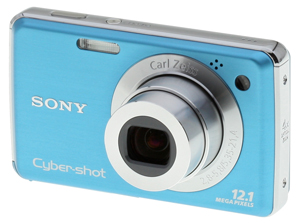Sony Cyber-shot DSC-WX1 Overview

Extremely small and attractive, the Sony WX1 has a few tricks under its hat that you'd never guess by just looking at it. The new feature this year isn't face detection or smile sensing -- though those things can be found on the Sony WX1--the new feature is low-light capability, allowing you to get shots indoors and at night that you never could before without getting blur from subject movement and camera movement. The Sony WX1 uses both an enhanced sensor, and very fast processing to achieve these tricks, and the results are impressive.
Along with the company's TX1 model, the Sony WX1 is one of the first two Sony Cyber-shot digital still cameras to feature a back-illuminated 'Exmor R' CMOS image sensor. Most sensors are front-illuminated, meaning that light must pass through a metal wiring layer before reaching the light-sensitive pixels. Some of the light is blocked by this wiring layer, reducing the sensor's ability to gather light. Back-illuminated sensors have the wiring layer below the pixels, so they collect more light. This improvement, says Sony, means a 200% increase in sensitivity over a traditional front-illuminated CMOS sensor.
The Sony Cybershot WX1 also includes the ability to stack multiple images shot at high sensitivity into a single exposure, resulting in reduced noise. It's a feature we've seen in the company's previous DSC-HX1 model, that Sony has refined in the WX1. The Sony WX1 is now able to detect subjects that have moved between shots, selecting only the frame in which they are most clear. The Sony WX1 also includes a Sweep Panorama function which automatically assembles panoramas from as many as 100 separate photos captured automatically, while you simply sweep your camera across the scene at the camera's direction. The WX1 is capable of horizontal panoramas covering as much as 256 degrees, or vertical panoramas with up to 175 degree coverage.
Sony Cyber-shot WX1
User Report

The Sony Cyber-shot WX1 is something of a sibling to the TX1, both offering the Exmor R sensor and Sweep Panorama, Handheld Twilight, Anti-Motion Blur, and HD video. But there are some important differences between the two -- and they aren't just matters of style.
The Sony WX1 is smaller but thicker. Pictures of the body often hide the darker back half of the camera because it's tapered to emphasize the sleek silver front half. And unlike the TX1's touchscreen interface, the Sony WX1 has a few more buttons and no touchscreen.
But the Sony WX1 has a more traditional, and very wide 24mm G lens with a 5x optical zoom, where the TX1 uses a folding zoom lens. Starting at 24mm is a big advantage over the starting 35mm focal length of the TX1 as is having a 5x zoom get the WX1 to 120mm, which is just short of the TX1's 140mm telephoto (in 35mm equivalents).
So if you're wondering how to decide between these two Exmor R cameras, focus on the interface and the lens. The other features (even the special ones) are pretty even.
Look and Feel. A credit card just about covers the WX1's face (the card is not quite wide enough, otherwise it would). But it's 0.75 inches thick and, with the lens extended, it's 1.5 inches thick.
Still, the Sony WX1 is a very pocketable camera and you'll have no qualms about taking it everywhere you go.
There is no grip to speak of on the little Sony WX1, but the raised "SONY" on the front gives your fingers something to grip. Your thumb on the back panel rests on the Mode dial. That was a problem for me. The Mode dial itself is easily moved and I found myself inadvertently changing modes as I was shooting.

On the top panel, the Power button is flush with the panel but not hard to find and use. A small LED to its left indicates whether the camera is on or off. You can also power up the Sony WX1 with the Playback button on the back (and not extend the lens) but you can't power it off that way. You can only turn off the Sony WX1 with the Power button.
The Shutter button is nicely designed as these things go, rising in a slight arch from the top panel. It's large enough to find without looking for it, too. The Release mode button to its right is so small you'll probably never notice it, leaving the camera on single shot mode (and missing the 10 fps at full resolution that the Sony WX1 can deliver).
The rest of the controls are on the Sony WX1's back panel to the right of the 2.7-inch Clear Photo LCD, which has 230,000 pixels. Top right is the Zoom toggle, which racks the G lens out smoothly and slowly enough to make image composition fun instead of frustrating. It doesn't stop suddenly when you release it, though, continuing on for just a moment longer to slow down, much like a good driver at a stop light. That often takes the Sony WX1's zoom beyond where you want it to stop, but once you learn to anticipate that, it's less of a problem.




